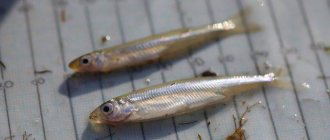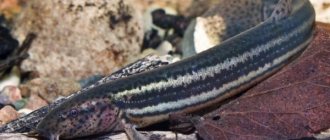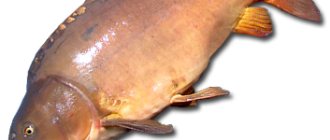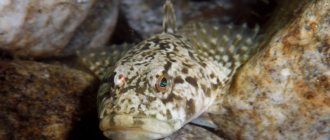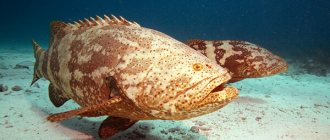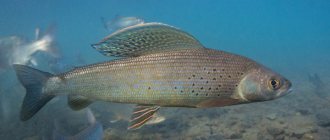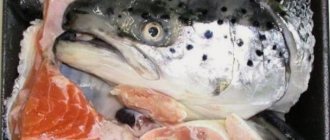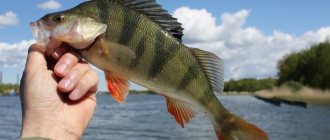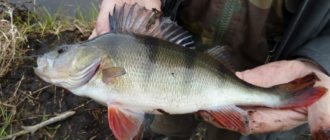A ubiquitous inhabitant of freshwater bodies of water is perch.
Its marine species are also known. The external structure of the perch is quite peculiar, compressed laterally and elongated in height. How do you cook perch?
- I fry 64%, 46 votes
46 votes 64%46 votes - 64% of all votes
- I make fish soup 14%, 10 votes
10 votes 14%
10 votes - 14% of all votes
- Salt 11%, 8 votes
8 votes 11%
8 votes - 11% of all votes
- I bake 7%, 5 votes
5 votes 7%
5 votes - 7% of all votes
- I bake pies 4%, 3 votes
3 votes 4%
3 votes - 4% of all votes
Total votes: 72
01.09.2020
- I fry 64%, 46 votes
46 votes 64%46 votes - 64% of all votes
- I make fish soup 14%, 10 votes
10 votes 14%
10 votes - 14% of all votes
- Salt 11%, 8 votes
8 votes 11%
8 votes - 11% of all votes
- I bake 7%, 5 votes
5 votes 7%
5 votes - 7% of all votes
- I bake pies 4%, 3 votes
3 votes 4%
3 votes - 4% of all votes
Total votes: 72
01.09.2020
×
You or from your IP have already voted.
General information
The structure of a voracious predator is interestingly formed. The body has its own characteristics. Without clear transitions, it consists of a small head with wide-opening jaws, a high, streamlined body with a wide back, and a tail. Just behind the head, a hump forms with age. For its characteristic feature, the perch is known among fishermen as the “humpback fish.” The weight of very small freshwater fish can be 50-70 grams, large ones - up to 3 kg, and sea bass reach truly gigantic sizes - 15 kg. But even large fish do not seem so big, since they grow mainly in height and thickness, and not in length. No matter how old a fish is, it rarely reaches more than 50 cm in length.
Only after reaching two years of age does river perch become sexually mature. Depending on age, perch lives at different depths. Combine a quiet place and thickets of reeds or old reeds, this will be an ideal place for the female to spawn. Usually early in the morning or before sunset. The length and width of the masonry can reach one meter. After a couple of weeks, the eggs will hatch into larvae that feed on small crustaceans. Perches will switch to predatory feeding when they reach a length of 10 cm. Adult perch often eat frogs and crayfish.
Large perch are quite agile and strong. Swims at high speed, often slows down and suddenly rushes forward again. Having chosen prey, it persistently pursues it. Walks in circles over the victim, opening its mouth. Looks scary. Small perches are not inferior in agility to their older brothers. They get so carried away in pursuit of prey that they jump onto the shallows or coastal sand. Purposeful hunting for large perch is akin to hunting for a rare animal. In any body of water there is a certain depth where large fish occupy places favorable for hunting. This is where you can catch a trophy bass. The process may take a long time, but it's worth it. As experienced fishermen say: “Perch loves to be searched for.”
Perch fins
Bending the laterally flattened body and tail first to the right and then to the left, the perch moves forward. When swimming, fins play an important role. Each fin consists of a thin membrane of skin, which is supported by bony fin rays. When the rays spread out, the skin between them tightens and the surface of the fin increases. Two pin fins
:
the front one is large
and
the back one is smaller
.
The number of dorsal fins may vary between different fish species. At the end of the tail there is a large two-lobed caudal fin
, and on the underside of the tail there is
an anal fin
.
All these fins are unpaired. Fish also have paired fins - there are always two pairs of them. Pectoral paired fins
(front pair of limbs) are placed on the sides of the perch's body behind the head, paired ventral fins (back pair of limbs) are located on the underside of the body.
The main role when moving forward is played by the caudal fin
. The paired fins are important for turning, stopping, moving forward slowly, and maintaining balance.
The dorsal and anal fins give the fish body stability when moving forward and making sharp turns.
External structure
The characteristic striped color distinguishes the perch from other fish. Light yellow belly, greenish, sometimes almost black back against a background of lighter yellowish sides. The presence of variegated stripes along the body is mandatory. There can be from 5 to 9, depending on the location and living conditions. Some species of perch do not have a pattern of stripes and may have dark spots of irregular shape. Huge orange eyes added to such a variety of shades make the perch unlike any other fish. Looks impressive. The intensity of the color is affected by the habitat, water quality and age of the fish. In open reservoirs it is light, in closed muddy reservoirs it is brightly expressed. Brown-green camouflage helps to hunt in dark water. Young perch, while growing up to two years of age, are usually one color. During spawning, the color of the perch acquires more saturated tones. All fins (dorsal, ventral, pectoral and anal) are also brightly colored in certain colors. The inhabitants of the deep sea of this family boast pink and red shades. There is a possibility of encountering blue or yellow specimens.
Reflexes of fish using the example of river perch
Observing the behavior of a perch in an aquarium, you can notice that its responses to irritation can manifest themselves in two ways.
If you touch the perch, it will instantly dart to the side. His response to the type of food is just as quick. A greedy predator, it quickly rushes at its prey (small fish and various invertebrates - crustaceans, worms). At the sight of prey, excitation goes along the optic nerve to the central nervous system of the perch and immediately returns from it through the motor nerves to the muscles. The perch swims to the prey and captures it. The mechanism of such body responses to irritation is innate - such reflexes
are called, as you already know,
innate
or
unconditional
. All animals of the same species have the same unconditioned reflexes. They are inherited.
If feeding fish in an aquarium is accompanied by any actions (conditions), for example, lighting a light bulb or tapping on glass, then after a while such a signal begins to attract fish on its own, without feeding. In response to such signals, fish develop acquired
, or
conditioned reflexes
that occur under certain conditions.
Unlike innate reflexes, conditioned reflexes are not inherited. They are individual and are produced during the life of the animal.
Goals:
- Educational: to reveal the features of the external and internal structure of fish in connection with life in the aquatic environment.
- Developmental:
- Educating
developing students’ ability to make observations, work with natural objects, and draw independent conclusions.
: to cultivate the student’s independence and self-esteem, to develop interest in the subject.
Principles: scientific, accessible, systematic and consistent, visual.
Materials: tables, laboratory equipment, live aquarium fish, river perch (wet preparations), instruction cards.
- verbal - explanation with elements of conversation.
- visual – the use of visual aids.
- practical – performing laboratory work
Lesson type: practical work
Lesson Plan
1. Organizational point:
- greeting students
- preparing students for work in the lesson, communicating the topic of the lesson.
- target setting
2. Studying a new topic:
Teacher's opening speech
The start of this lesson will be a riddle, the answer to which will suggest the topic of our lesson:
It has wings, but it doesn’t fly, there are no legs, but you can’t catch up? (Fish)
Fish are aquatic animals. The reservoirs in which fish live differ in the salinity of the water, its oxygen saturation, and temperature. Most fish species live in the seas. Some of them live in the water column (sharks, tuna, cod), others (skate, flounder) live in the bottom layers of the reservoir or at the bottom.
Fish from different habitats differ in shape, color and other characteristics. However, they have common structural features. We will find out what the external and internal structure of fish is using the example of aquarium fish and river perch. To do this, we will conduct laboratory work.
Practical work in small groups.
The class is divided into two groups, each group works on a problematic practical task, the results of which allow us to draw a conclusion about a certain property of a living organism. The results of student work are summarized at the end of the lesson and conclusions are drawn.
Tasks for group No. 1. External structure of fish
Purpose of the work: To find out the features of the external structure of fish in connection with the aquatic lifestyle.
Object of study: aquarium fish, river perch, tables, textbook drawings, instruction cards.
Instruction card
- Watch the fish swimming in the aquarium. Note what parts her body consists of.
- Examine the fish's head. What organs are visible on the head? How are the fish's eyes located?
- Examine the body of the fish. Determine what it is covered with; how the scales are located. Why do the scales have this arrangement?
- Look at the lateral line on the fish's body - a chain of tiny holes.
- Examine the fins of the fish. How many are there; where are they located? Determine which fins are paired and which are unpaired.
- Observe the work of the fins when the fish is motionless, turns, floats up, dives, and quickly moves forward.
- Fill the table:
- Note the role of fins for the life of fish in the aquatic environment.
- In your notebook, write down your conclusion about the adaptability of the external structure of the fish to life in water.
Assignment for group No. 2. Internal structure of fish.
Purpose of the work: To study the location of the organs of the body cavity and the main stages of development of bony fish.
Facilities and equipment; wet preparations “Internal structure of fish”, “Development of bony fish”; tables, textbook pictures, instruction cards.
Instruction card.
- Using wet preparations, find out which organs are located in the body cavity of a fish? What systems do these organs belong to?
- Consider the wet preparation “Internal structure of fish”. Find the swim bladder, gills, heart, intestines, kidneys, and liver on it. What systems do these organs belong to?
- What organs belong to the reproductive system of fish? Find the organs of the reproductive system on the wet preparation “Internal structure of fish”.
- Most bony fish are spawning fish. Examine the wet preparation “Development of bone fish” and find on it the main stages of fish development. Using the textbook pictures, find out what characterizes the main stages of fish development?
- Present the results of your work in your notebooks in the form of a table. Fish body cavity organs
- A kind of sensory organ.
- Front pair of limbs.
- Respiratory system.
- Vessels leaving the heart.
- Small holes.
- Protective cover.
Filled with a mixture of gases.
Answers:
| 4 | 2 | 6 | 1 | 3 | 5 | 7 |
4. Lesson summary:
- analysis of students' work by the teacher;
- issuing and commenting on ratings.
Homework:
pp. 176 – 179, assignment on p. 185.
Perch is one of the most common fish in our freshwater bodies and one of the most favorite objects of “hunting” for amateur fishermen, both in summer and winter. There is already an article about that on the site. There we talk about why this striped predator is so loved by fans of winter fishing. And here I would like to introduce readers in more detail to this wonderful fish. During zoology classes in high school, we all studied the “Fish” section using perch as an example. I remember well how, at the request of the teacher, I brought several perches to a laboratory lesson in the 7th grade, which we dissected ourselves to study the internal structure of the fish. It was a long time ago, more than 40 years ago. Nowadays they hardly do this anywhere in school lessons. Yes, and there is no need for this. After all, there are not only colorful textbooks with all the diagrams and drawings, but various, as they say now, interactive materials with which you can “dissect” a perch on a computer screen. So students have the opportunity to study the structure of a perch, even if they have never caught one in their lives, but have never even seen one. I accidentally looked into an old zoology textbook (1977) for grades 6-7 in high school. I looked at how, using the example of perch, children were taught (and are now taught) the zoology of fish in our schools, although this fish has many features that distinguish it from others. It’s no coincidence that L.P. Sabaneev gave this description of the appearance of the perch
: “
In its structure and body color, perch is easily distinguished from all our other fish.
Its body is quite wide, especially in large perches, and somewhat humpbacked; the back is dark green, the sides are greenish-yellow, the belly is yellowish; 5-9 transverse dark stripes stretch across the entire body, which make it very motley; in some cases, these stripes are replaced by dark, irregular spots. In addition, the caudal fin, especially in its lower part, the anus and ventral fins are bright red; The pectoral fins are yellow, the first dorsal fin is gray, with a large black spot at the end, the second is greenish-yellow. The eyes are orange. However, the color of the perch depends, like most fish, on the quality of the water, and even more on the color of the soil. Therefore, perches in clear water with a light sandy or clay bottom are very light, sometimes even without a black eye on the dorsal feather and with inconspicuous transverse stripes. On the contrary, in forest lakes with a black muddy bottom they have darker stripes, a darker back and a bright yellow belly. In some areas (as, for example, in Lake Senezhskoe, Moscow province) perches even have golden gill covers. In addition, it should be noted that young perches up to the age of two are of the same color, having reached sexual maturity, and that the largest ones are comparatively darker. On the gill covers there is one sharp spine, which pricks very painfully and can even cause swelling and mild inflammation. The mouth is very large, armed with numerous but very small teeth.
I photographed the drawings from this old textbook to clearly demonstrate the structure of the perch.
The external structure of the perch is shown in the first picture. Perch, like most fish, has a streamlined body shape that allows it to move quickly in the water.
The perch's head smoothly transitions into the body, and the body into the tail. At the pointed front end of the head there is a mouth with lips that can open wide. On the top of the head two pairs of small holes are visible - nostrils leading to the olfactory organ. On its sides there are two large eyes.
But here is the description of perch given in a more scientific work - Key to Freshwater Fishes of the Fauna of the USSR. (author Veselov E.A., M. Prosveshchenie, 1977, p. 178): “ The body, laterally compressed, oval, covered with small scales. The cheeks are completely covered with scales. There are no fangs. The gill membranes are not fused to each other. Gill rays 7. Two dorsal fins, not fused together; in the first fin there are from 13 to 16 spiny rays, in the second - from 1 to 3 unbranched rays and from 13 to 15 branched rays. The anal fin has 2 unbranched and 8-9 branched rays. There are 57-77 scales in the lateral line. There are 14-20 gill rakers. The pelvic fins are slightly longer than the pectoral fins. Body greenish-yellow. There are 5-9 transverse black stripes on the sides. Fins: dorsal - gray (with a black spot), second dorsal - greenish-yellow. Breasts are yellow, the rest are red
.»
The Latin name for the perch is also given - Perca fluviatilis Linne
.
In a school textbook about fins it is written in simpler language: “Bending the body and tail now to the right, now to the left, the perch moves forward. The fins help with this. Each is a double layer of skin supported by hard, bony fin rays. Many of them are transformed into sharp spines in the perch. When a perch is attacked by enemies (enemies of the perch - catfish, pike, burbot, water birds), the splayed spines of the fins provide protection. There are unpaired fins - dorsal (perch has two of them), caudal and subcaudal (anus) and paired - pectoral and abdominal. The main role when moving forward is played by the caudal fin. The paired fins serve as depth rudders and are also important when turning, stopping, moving forward slowly and maintaining body balance.” I would like to add that these fins allow the perch not only to move forward, but also to slowly “back away”. More than once I had the opportunity to observe in a hole how a perch, slightly moving its fins, moves back from the bait, which it did not like.
Perch is not the fastest swimmer among fish. A pike, for example, can reach a much higher speed when throwing itself at a prey, but a perch can swim at speeds of up to 20-22 km/h while chasing a fry.
Cover and color of perch.
The body of the perch is covered with bony scales, each of which with its rear edge overlaps the scales of the next row, forming a protective layer - scales that do not interfere with body movements. Perch scales are so strong that it is difficult to tear them off even when cleaning with a knife. The scales are covered on top with thin skin, the glands of which secrete mucus, which reduces friction with water during movement and serves as protection against bacteria and mold.
The belly of the perch is lighter than the back, which serves as a good camouflage. From above, the dark back is less noticeable against the background of the dark bottom, and the light belly is less noticeable from below against the light background of the water surface. Dark stripes on the greenish sides help the perch to camouflage perfectly in thickets of river grass. The color of perches varies greatly depending on the bodies of water in which they live. In muddy, peaty lakes, perches have a very dark, almost black color, and in reservoirs with a sandy bottom there are perches with a very light, bright color. The protective coloration helps the perch hide from enemies and lie in wait for its prey in ambush.
Friends! Today we will continue to study the structure of river perch.
Coverings of the body
Scales
The body of the fish is densely covered with medium-sized bony scales. Dark transverse stripes are clearly visible on it. The scales are arranged overlapping, very often and closely adjacent to the skin. The lateral line contains up to 70 scales. The posterior edge ends in a ridge of small spines. The protective shell is covered with mucus produced by the skin glands. The mucus cover is responsible for protecting against friction with water and the penetration of unnecessary bacteria.
Perch fins
The perch moves forward, bending at the tail. A specific mission during wave-like movement is performed by fins that have a bone-membranous structure. The rays move apart, stretch the membranes and increase the size of the fins.
A pair of fins pass one after another on the back. Immediately behind the head is a larger and longer one, followed by a smaller one. The first fin is more prickly, the second is softer. The large fin is gray or green with a characteristic black spot, the smaller one is green-yellow. Sometimes the dorsal fin is fused.
The pectoral fins of the perch are colored a brighter yellow. Anal, with a couple of spiny processes of a bony structure, red. All perches are distinguished by pink-red ventral fins. The lower part of the two-lobed caudal fin is also red.
Head and teeth
The bone elements of the skull protect the head from mechanical damage. There are gills on the sides. The respiratory apparatus is protected by gill arches. The head of the perch is disproportionately small. But the mouth is a very decent size. The predator knows how to open it quite wide. The jaws are equipped with several rows of bristly teeth. So, once falling into his mouth, the victim has no hope of salvation. Connect jaws like these and there is no turning back. With the help of sharp spines of a bony structure on the gill covers, it provides itself with reliable protection from predators. Fishermen know how many problems they cause, how deep a cut they can leave.
Hearing organs
The fish may not see us, but its hearing is excellent. Water is an excellent conductor of sound vibrations. Inexperienced fishermen, having made some noise before fishing, are then surprised at the poor bite. With the help of the hearing organ in fish, sound waves are captured:
- inner ear;
- lateral line.
Sound is picked up in water by the entire surface of the fish’s body. The swim bladder of a river perch acts as a resonator and helps to capture external vibrations by transmitting them to the inner ear. Predators are classified as moderately hearing fish, since their swim bladder and inner ear are not connected to each other. They have to rely more on their vision.
Skeleton
The purpose of the skeleton is to serve as a support for muscles and protect internal organs. The skeleton of a perch consists of a large number of bones. The spine, formed by absolutely identical vertebrae, stretches from head to tail and forms its basis. The total number of vertebrae is from 39 to 42. Each consists of a thickened part called the body and a superior arch. The spinal cord is located in the spinal canal formed by them. The ribs extend from the vertebrae. The spine ends with a caudal fin. In the front part it is connected to the skull. In the caudal region, the vertebrae are equipped with a lower arch. Closing processes extend upward from the disc. The lower lateral processes do not close. The bone structure determines movement.
Perch fins
Bending the laterally flattened body and tail first to the right and then to the left, the perch moves forward. When swimming, fins play an important role. Each fin consists of a thin membrane of skin, which is supported by bony fin rays. When the rays spread out, the skin between them tightens and the surface of the fin increases. Two pin fins
:
the front one is large
and
the back one is smaller
.
The number of dorsal fins may vary between different fish species. At the end of the tail there is a large two-lobed caudal fin
, and on the underside of the tail there is
an anal fin
.
All these fins are unpaired. Fish also have paired fins - there are always two pairs of them. Pectoral paired fins
(front pair of limbs) are placed on the sides of the perch's body behind the head, paired ventral fins (back pair of limbs) are located on the underside of the body.
The main role when moving forward is played by the caudal fin
. The paired fins are important for turning, stopping, moving forward slowly, and maintaining balance.
The dorsal and anal fins give the fish body stability when moving forward and making sharp turns.
Excretory system
The excretory and genitourinary systems of fish are interconnected. The genitourinary system of fish includes:
- kidneys;
- bladder;
- ureters.
The kidneys are located along the vertebral circles and are designed to maintain normal blood chemistry.
Kidney functions
Do fish have kidneys? They are located above the swim bladder, under the spinal column. They fit tightly to it. They are a paired ribbon-like organ of a rich red hue. Many small wire tubules emerge into a single duct. The most important role is that filtration is well developed in fish living in fresh water bodies. Water enters the body through the gills or intestines. After breakdown, it is excreted by the kidneys in the form of unnecessary substances. The end product is toxic ammonia. Three sections of the kidneys: the head kidney (anterior section), middle and posterior sections. Important Features:
- purification of blood from decay products by filtration, removing them from the body;
- control over fish homeostasis;
- maintaining the acid-base balance of the internal environment;
- removing excess water;
- regulation of the required blood volume.
Do you have a bladder?
Substances and unnecessary salts formed during the life process are removed from the bladder through the ureters. The ovaries are located nearby. Here the eggs mature in order to leave the female through a special hole during the breeding season.
The genitourinary system of marine fish is designed to retain water, while in freshwater fish it is needed to pump it out of the body. Based on this, the amount of urine in freshwater fish is 10 times higher than that in marine representatives of the family.
Internal structure
The structure of the perch seems primitive in comparison with other vertebrates. Actually this is not true. The body cavity is equipped with all the necessary organs for digestion:
- esophagus;
- stomach;
- intestines;
- liver.
There is a swim bladder, heart, gonads and kidneys.
Swim bladder of a perch
The first representatives with a developed spine structure are fish. Evolutionary changes helped them adapt to the water element. In theory, the perch should drown, since it is heavier than water, but there is a bubble in its abdominal part. It is based on gas. This is what keeps the fish in the water and prevents it from drowning. Its capacity allows the predator to control a certain height of the bottom, float and dive. Perch can easily move in the expanse of water without expending much energy. This unique organ appears in the embryo as an intestinal outgrowth. Having reached the larval stage, the connection with the intestines is lost. A couple of days after hatching, the larva needs to ascend to the surface to take a sip of air and fill the bladder. Without this, the larva will not be able to swim and will die. When compression is necessary, excess gas from the bladder is quickly absorbed into the blood. When expanding, it enters the bladder from the blood. When an adult perch dives to depth, the bubble contracts and the density of the fish becomes higher. This ensures quick immersion. If necessary, the fish becomes lighter due to the increase in the volume of the bubble. At a constant depth, the size of the swim bladder remains unchanged. The fish is able to hover in the water without moving. Thus, the main purpose of the bubble is the buoyancy and maneuverability of fish.
Digestive system
The digestive system is an important component of the internal structure of perch. Elements of the digestive system:
- oral cavity;
- throat;
- tubular muscular organ (esophagus);
- intestines;
- pancreas;
- cholecystis (gall bladder).
The upper and lower jaws are equipped with many teeth. From the mouth, all food enters the pharynx and is then pushed through the esophagus through muscle contractions. It enters the voluminous stomach, the main organ of the digestive system. Stomach juice breaks down food. Digested food enters the intestines. Here, under the influence of the juice produced by the pancreas, it releases nutrients. Bile and juices from the intestinal glands also take part in the digestive process. Nutrients are absorbed into the blood by the intestinal walls. All dangerous compounds are neutralized in the liver. Parasites love to live here. Unprocessed residues are discharged through the opening.
Where is the operculum located?
Bony fish are equipped with a bony gill cover, completely covered with small serrations. Like most fish, perch has 4 pairs of gills. Whole gills are located on the same number of gill arches. In addition, the inner side of the operculum hides the semi-gill. It is also called sublingual or false. Therefore, in place of the five gill openings characteristic of cartilaginous fish, one gill slits formed. Cartilaginous fish cannot boast of having an operculum. There are sharp spines on the gill covers of the perch. Care should be taken as wounds from these thorns often become inflamed and swollen.
Two-chambered heart
How many chambers does a perch have in its heart? It is not equipped with an arterial cone, like other fish organisms. Since perch is a cold-blooded fish, its circulatory system is closed. The heart has two chambers - an atrium and a ventricle. To compensate, there is the aortic bulb, which represents the expansion of the beginning of the aorta. Unlike the conus arteriosus (division of the heart), the aortic bulb does not have the ability to pulsate independently, being devoid of transverse muscles and valves.
The digestive system of fish using the example of river perch
Perch is a predator. It feeds on a variety of aquatic animals, including other species of fish. The perch captures and holds its prey with sharp teeth sitting on its jaws. After swallowing, food passes through the pharynx and esophagus into the stomach. Perch swallows its prey whole, and therefore its stomach has the ability to greatly stretch. Microscopic glands in the walls of the stomach secrete gastric juice
.
Under its influence, food begins to be digested. The partially modified food then passes into the small intestine, where it is acted upon by the digestive juice of the pancreas and bile coming from the liver. The supply of bile is stored in the gallbladder
. Nutrients penetrate through the walls into the blood, and undigested residues enter the hindgut and are thrown out.
Sense organs
Of the perch's available sense organs, the eyes are the most important. The eye lens is characterized by a round shape. The ability of fish to distinguish objects at an equal distance is due to the rotation of the lens along the optical axis. The flat structure of the cornea of a predatory creature is important for excellent visibility at depth.
In addition, the fish’s olfactory organ is also well developed. The nostrils have both an inlet and an outlet. The olfactory sac, located inside the nose, has many folds. All of them are covered with olfactory epithelium.
Respiratory system
The openings of the respiratory system are located in the throat area. The gills, covered with a bony plate, come to the surface. By working the muscle, the bony plate can move, facilitating the flow of water to the gills. At this time, they are saturated with oxygen. The apparatus responsible for the respiratory process consists of four pairs of arcs. Quite rigid arcs are located vertically. To them, in turn, gill arches are attached in large numbers. The petals hid many tiny capillaries inside themselves. They provide gas exchange. In this way, oxygen quickly flows from water into the circulatory system, and carbon dioxide from the body. On the throat side, the gills have special stamens. They prevent the leaves from becoming clogged with particles from the food of the petals.
Circulatory system
The closed circulatory system of perches, like that of frogs, allows blood saturated with carbon dioxide to be pumped through the heart, consisting of two chambers, in an infinite number of circles. Blood makes its way to the gills, where it is distributed through the capillaries. The goal is oxygen saturation. The next step is to redirect the blood to the dorsal aorta. Finally, from here the blood will be delivered to all organs of the body, including the brain.
The fish called perch lives everywhere in the Northern Hemisphere. For a comfortable stay, a weak current and average depth are enough for him. It is important that the predator’s hunting grounds be provided with underwater vegetation. Thanks to these factors, a high number of perch will be ensured. And its high numbers, in turn, make it the main target of fishing. What benefits the consumer? Ordinary perch is a very tasty and healthy fish. Nutritionists strongly advise including perch in your diet as often as possible, as the fish is rich in phosphorus. There are no contraindications.
The circulatory system of fish using the example of river perch
Figure: Internal structure of river perch. Circulatory system
Figure: Structure and function of river perch gills
The circulatory system of fish is closed. It consists of the heart and blood vessels. The vessels leaving the heart are called arteries
, vessels bringing blood to the heart are
veins
.
The heart of the fish is two-chambered
.
It consists of an atrium
and
a ventricle
, the muscular walls of which alternately contract.
From the atrium, blood is pushed into the ventricle, and from it into a large artery - the abdominal aorta
.
Valves prevent blood from flowing back. The abdominal aorta goes to the gills
, where the blood is dark in color, saturated with carbon dioxide and called
venous
.
In the gills, the vessels branch into capillaries
.
The blood flowing in them is freed from carbon dioxide and saturated with oxygen. In the vessels extending from the gills, scarlet, oxygenated blood
.
It gathers into the dorsal aorta
, which runs along the body under the spine. In the caudal region, the dorsal aorta passes through the lower vertebral arches.
From the dorsal aorta branch smaller arteries that branch in various organs to capillaries. Through the walls of these capillaries, oxygen and nutrients enter the tissues, and from them carbon dioxide and other waste products enter the blood.
Gradually, the scarlet arterial blood darkens and turns into venous blood, containing a lot of carbon dioxide and little oxygen. Venous blood collects in the veins and flows through them into the atrium. Thus, the blood continuously circulates in one closed circulatory circle
.
